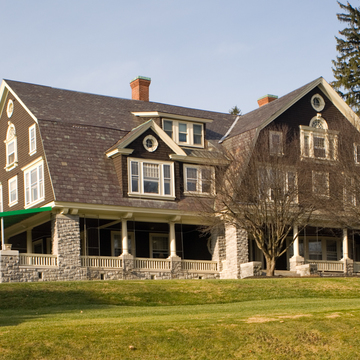You are here
Linden Terrace (Herman Vaughan House)
The Shingle Style house of International Paper Company director Herman Vaughan brought the imagery of grand coastal “cottages” to Grove Street. In scale it is a counterpart to the earlier mansions of Rutland magnates. The house has the expansive simplicity of late Shingle Style, purged of picturesque eccentricities under the influence of Colonial Revival. Arthur H. Smith had established a reputation for Tudor and Colonial Revival work with a fine sense of composition and detail. His unified scheme for the Vaughan house utilized a massive slate gambrel roof rising above a deep, shadowy, continuous veranda. Formed by powerful piers of rusticated gray marble interspersed with Doric columns, the veranda screens a recessed first floor animated by sheltered bay windows. Facade variety comes from a huge off-center cross gambrel and a mix of gabled and shed dormers. Fine details, indicative of the level of refinement of Colonial Revival in Rutland, are picked out in white against the dark wood shingles. Sash windows in a variety of sizes and clusters combine with the decorative accents of a third-floor Palladian window and keystoned bull's-eye gable windows. The whole conveys an air of substantial, quiet ease.
Writing Credits
If SAH Archipedia has been useful to you, please consider supporting it.
SAH Archipedia tells the story of the United States through its buildings, landscapes, and cities. This freely available resource empowers the public with authoritative knowledge that deepens their understanding and appreciation of the built environment. But the Society of Architectural Historians, which created SAH Archipedia with University of Virginia Press, needs your support to maintain the high-caliber research, writing, photography, cartography, editing, design, and programming that make SAH Archipedia a trusted online resource available to all who value the history of place, heritage tourism, and learning.


